Leaves Change Fortunes of Depopulated Town
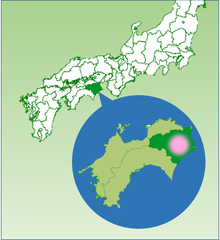 The demographic phenomena of depopulation and aging accompanied by a low birthrate are advancing in Japan. But there is a community where the elderly residents and younger newcomers and returnees enjoy sprightly lives. This town has a population of about 1,700 people, almost all of whom are aged 65 years or over. Among them, there are said to be some elderly residents earning an annual income of ¥10 million through farming. And among the younger residents, there is one who used to work for a bank and another ambitious woman who hopes to invigorate the community by using the knowledge she learned at an overseas university. I visited this provincial town located in a mountainous area of Tokushima Prefecture to see what attractions it has that appeal even to such young people.
The demographic phenomena of depopulation and aging accompanied by a low birthrate are advancing in Japan. But there is a community where the elderly residents and younger newcomers and returnees enjoy sprightly lives. This town has a population of about 1,700 people, almost all of whom are aged 65 years or over. Among them, there are said to be some elderly residents earning an annual income of ¥10 million through farming. And among the younger residents, there is one who used to work for a bank and another ambitious woman who hopes to invigorate the community by using the knowledge she learned at an overseas university. I visited this provincial town located in a mountainous area of Tokushima Prefecture to see what attractions it has that appeal even to such young people.

Ms. Yukiyo Nishikage
Leaves Resuscitate the Community
After a drive of about 90 minutes from Tokushima Airport that took me through the city of Tokushima and out onto a mountainous road, I eventually arrived in the town of Kamikatsu-cho in Tokushima Prefecture, which is the smallest town in Shikoku. Kamikatsu-cho was becoming deserted as a result of depopulation, but its fortunes changed thanks to seasonal leaves called tsumamono, and it is now a vibrant and cheerful town radiating hope. Tsumamono are the garnishes or decorative leaves, such as bamboo grass or maple leaf, that often adorn Japanese cuisine. The high-quality tsumamono of Kamikatsu-cho are very popular, with orders coming in from around the country. They are used at high-class Japanese-style restaurants (ryotei), including the famous Kitcho in Kyoto. It is the town’s hearty elderly women, aged 70 years or over, who cultivate and ship the leaves.
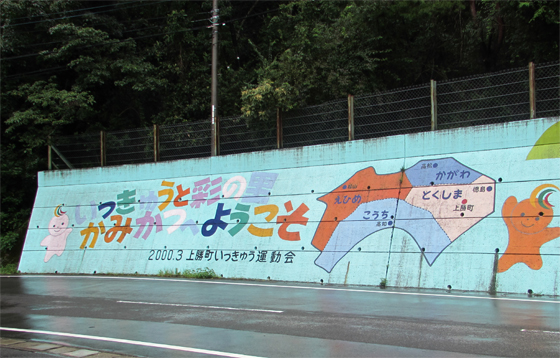
Kamikatsu-cho gets visited by many news reporters, local government officials, and delegations from overseas who, hearing about the town’s achievements, want to know more about the secrets of its success and its activities. I asked Mr. Tomoji Yokoishi, the founder of Kamikatsu-cho’s leaf business and president of Irodori Co., Ltd., to tell me the story.
Interview with Leaf Business Founder Tomoji Yokoishi
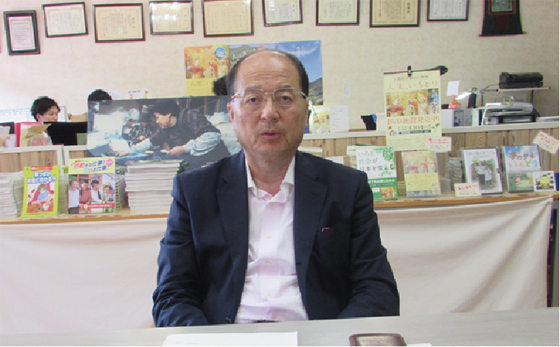
Mr. Tomoji Yokoishi
Moment of Inspiration in Osaka
Q: What was the trigger for starting the leaf business?
Yokoishi: Mikan [tangerine oranges] used to be the main industry in Kamikatsu-cho, but an abnormal cold spell in February 1981 wrought catastrophic damage. We then tried to cultivate light vegetables, such as spinach and spring onion, and shiitake. But the elderly people could not manage the heavy trees required for cultivating shiitake, so we had to look for a replacement. One day I happened to be eating in a restaurant in Osaka’s Namba district. A group of three female university students was there as well, and one of them was pointing to the red maple leaf adorning her dish and excitedly exclaiming how pretty and cute it was. When I saw that scene, I had this flash of inspiration: “That’s it! We’ll sell leaves!”
The Pride of Elderly People in Kamikatsu-cho
Q: And did everything go well from the start?
Yokoishi: When I returned from Osaka, I spoke to people in the agricultural cooperative where I worked and local farmers about the potential of leaves, but they flatly opposed the idea. “Money doesn’t grow on trees,” they said. “If money could be made from leaves, we would be building palaces all over the place!” They really ridiculed and scoffed at me. And elderly farmers were ashamed at the thought of picking up leaves; it hurt their pride so much.
But I carried on with the following three resolutions: “I would gain the trust of local people, I wouldn’t whine, and I would increase the incomes of local people.” Eventually four flower and tree farmers said they would have a go, and we launched the Irodori brand, which was the start of the leaf business. That was in 1987. At first, however, our leaves were seen as nothing more than garbage in the market and didn’t sell at all.

Talking to Chefs to Understand Their Needs
Q: So why did sales eventually take off?
Yokoishi: One day a chef looked at our Irodori leaf products and told me bluntly that he couldn’t use them. And he was right. I had started the leaf business without investigating the opinions of kitchen chefs and the tastes of the customers eating in their restaurants.
So I decided to go and see for myself. I marched through the back doors and into the kitchens of high-class restaurants to hear what the chefs there had to say. But they just ignored me. When I persisted, they sometimes treated me quite dangerously in ways that I really can’t describe here. Thirty years ago the world of Japanese chefs was very feudalistic and strict.
So I decided to visit these restaurants as a customer, and it was completely different. They explained matters to me very courteously, and I relayed what I saw and heard to our farmers back home. As a result, our leaves improved in terms of both appearance and quality and began to sell at a good price in the market. In exchange for that, though, because of my repeated visits to high-class restaurants, I ended up with gout! [Laughs]
Rural Areas and Elderly People Need IT
Q: What is the reason for the success of the leaf business?
Yokoishi: We were able to build trust between the elderly women working on the farms and the people in the market, and I was able to reflect what I witnessed at firsthand at the restaurants in the farm work. And another important factor was the promotion of information technology. I had the elderly women master how to operate computers so that we could use the point-of-sale systems of convenience stores to see their stocks of leaves and manage shipments. I modified the personal computers so that elderly folk could use them. It’s good for their health too. By analyzing the information obtained from computers, the elderly women improve their powers of thinking, and use of their fingertips stimulates the brain. I think building this information setup was a key factor in our success.


Locally produced leaves casually decorate dishes in a Kamikatsu-cho café.
Constantly Planning New Challenges
Q: Finally, please tell us about your future plans.
Yokoishi: One of my plans is to expand the export of leaves overseas. This year I went to France and Thailand to promote sales to Japanese restaurants and others there, and thankfully Kamikatsu-cho leaves are now boarding international flights and going overseas. This is an enormous boost to the confidence and pride of our elderly women farmers.
My second plan is to train successors, which means getting young people to come and live here from the cities. For this purpose, we are creating opportunities for people interested in Kamikatsu-cho to come into contact with the locals through farming experience and so on. We call this “matching space.” It enables people to check their mutual compatibility beforehand.
And my third plan is to create “Irodori mountains.” I want to revitalize the neglected mountains around our town and make them colorful and beautiful. Tourists would then flock here from Japan and overseas to see the cherry blossoms in spring and the colorful foliage in autumn and to engage in exchange with our elderly women farmers.
Yukiyo Nishikage: Regaining Youthfulness by Growing Leaves
I asked Ms. Akemi Nakata, a staff member of Irodori Co., Ltd. who experienced study abroad in her university days, to show me a leaf-producing farm. When we arrived at the house, we were greeted by a smiling Ms. Yukiyo Nishikage, who is 78 years of age, and Ms. Ryu Sho, a Chinese student studying at the graduate school of Hokkaido University who was visiting Kamikatsu-cho as an intern. Ms. Ryu had learned about the program at a university seminar and, interested in the scheme, applied to participate.
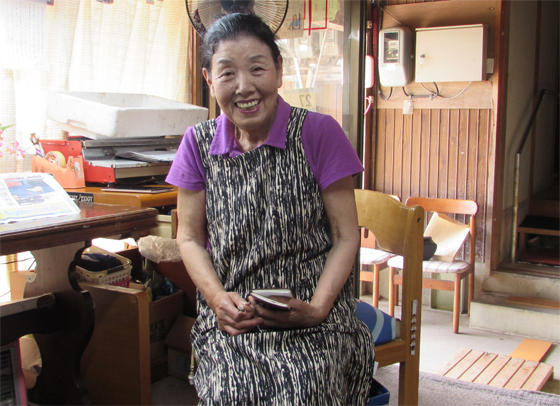
A very youthful-looking Ms. Yukiyo Nishikage
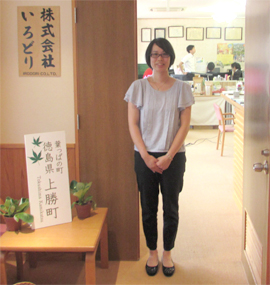
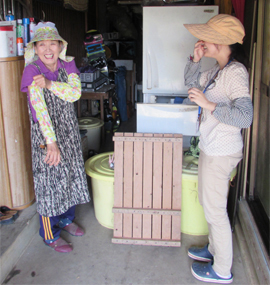
Ms. Nishikage (left) and Ms. Ryu
Serious Approach to Work
In a garden thick with foliage, Ms. Nishikage gave detailed instructions to the intern. “Select leaves of around this size,” she said, armed with scissors and ruler, “and cut them about here.” The two then went about their work silently, plucking leaves from the trees. Indeed, they seemed so serious, I was hesitant to open my mouth.
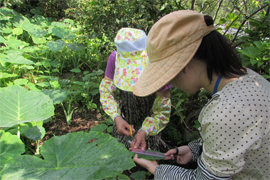
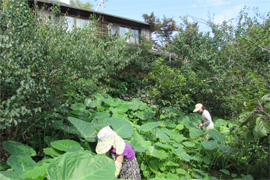
When the signal for 10 a.m. sounded, Ms. Nishikage hurried indoors and headed straight for a computer. Manipulating a specially designed mouse, she stared intently at the screen. “I’m looking at orders from the agricultural cooperative [the Kamikatsu-cho branch of JA East Tokushima]. I made a bid, but a cross has come back. Somebody got there first. If you want to win an order, you have to move fast,” she said ruefully. It reminded me of day-trading in shares.
Apparently when Ms. Nishikage has trouble with the computer, an Irodori staff member comes to help immediately. The availability of this supportive backup system is most reassuring. It seemed to me that the tremendous passion for the leaf business stems from these solid bonds between the elderly women and related parties who support them, plus a little gambling spirit.
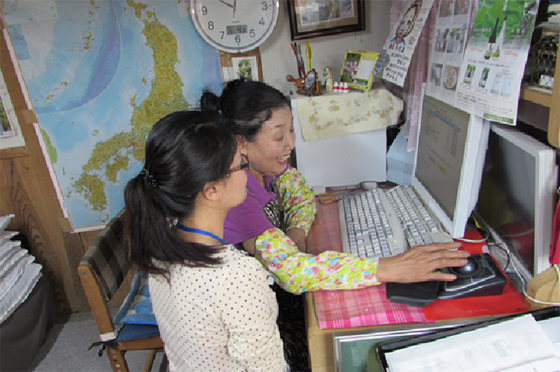
Ms. Nishikage and Ms. Ryu gaze intently at order information.
Give Them Something to Do, and People Become Positive
Ms. Nishikage looks 10 years younger than her actual age and is really sprightly. “I used to cultivate oranges, chestnuts, and other crops while working for a textile company,” she explained, “but now I just do this work. Leaves are light and pretty, so elderly folk like me can do this work without any trouble. And bright young interns like Ms. Ryu come to help us. It gives me a real zest for life.”
People get a sense of self-esteem and purpose in life by having a job and engaging in exchange with others. I think this is true not only for the elderly but for all generations.

Ms. Nishikage uses a tablet computer.
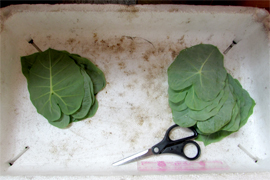
Leaves harvested that day for shipment
Takuya Takeichi of the Yoo-Hoo Research Team:
Love for the Local Landscape
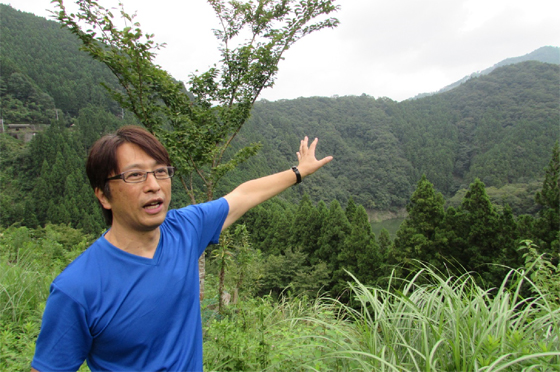
Takuya Takeichi explains how to call "Yoo-hoo!" and how to prepare yourself.
Local Nature Becomes Tourist Resource
In Kamikatsu-cho, which is surrounded by mountains, the Kamikatsu Yoo-Hoo Research Team is attracting attention as a unique effort to utilize nature. In order to make people even more familiar with the phenomenon of mountainous echoes, whereby if you shout “yoo-hoo” at a mountain, the sound waves bounce back off the mountain and repeat the call, the team offers yoo-hoo certification of knowledge relating to echoes and also competency in blowing a conch shell. This project was started by the handsome Takuya Takeichi of Kamikatsu-cho. As well as ordinarily running the Takeichi Shoten store (the catchphrase of which is “Everything from underwear to Dom Perignon!”), Mr. Takeichi serves as the town’s entertainer in his role of charismatic yoo-hoo certifier.
Thinking it would be a good memento of my trip, it was with a lighthearted attitude that I had a go at the yoo-hoo experience under the guidance of Mr. Takeichi.
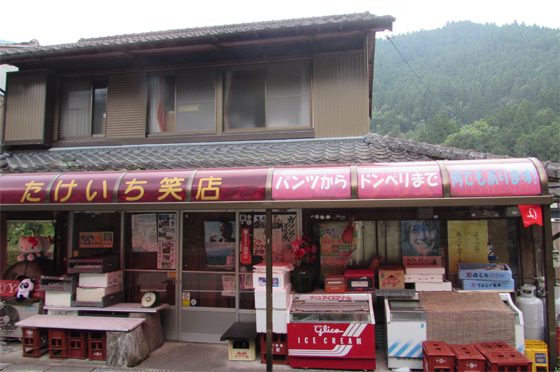
The Takeichi Shoten stocks just about everything.
Simple yet Engrossing “Yoo-Hoo!”
“Look toward the mountain with a feeling of reverence,” Mr. Takeichi instructed. “Calling to the mountain means delivering the spiritual power of language to the mountain, so you must send a beautiful word.”
“So,” he went on, “turn your left hip vertically toward the mountain and place your left hand on that hip. Place your right hand on your mouth and then, at the same time as you call ‘Yoo-hoo!’ turn your right hip horizontally to face the mountain. Okay? Right, have a go!”
As it is rare for me to shout at the top of my voice, I felt a little embarrassed. My first shout was weak and did not create a good echo at all.
“The way to produce a loud shout is to go through three stages,” Mr. Takeichi explained. “First, just kind of whisper; second, make it a bit louder; and third, shout as loud as you can from the bottom of your belly. When you do that, you’ll get a clear echo back.” When I tried just as I was told, I did indeed get a pretty good echo in return.
Thrilled by my success, I tried calling out “I love you!” and the echo came right back to me. (Nobody has ever said that to me before . . . !)
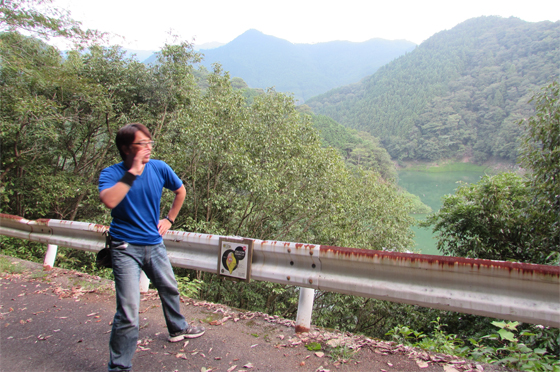
The standard pose for calling "Yoo-hoo!"
Conch Shell Blowing Requires Perseverance
My next challenge was to blow a conch shell and send the sound reverberating across the mountains. After hearing Mr. Takeichi do so, I tried several times myself, but nothing but a dull sounded emanated from the shell.
“The technique,” Mr. Takeichi advised me, “is to press the corners of your lips over the mouthpiece, apply pressure with your built-up breath, and then blow.” I tried again several times, and gradually the shell began to produce sounds. I kept on trying until my lips started to tingle, and eventually I was creating a booming sound that reverberated across the mountains. Maybe I’m exaggerating a little, but I felt a great sense of accomplishment.
Before participating, I made light of the yoo-hoo and conch shell experiences. But when I went along, I really did get carried away and put my heart and soul into them.
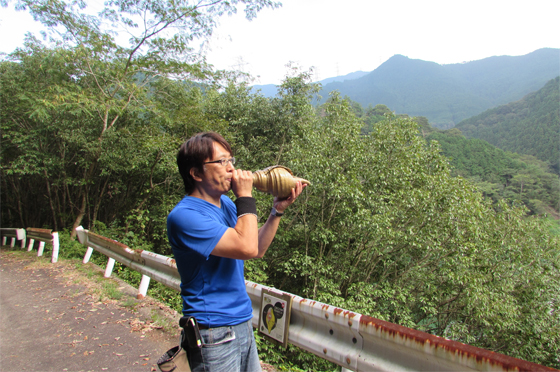
Only chosen people can blow the golden conch shell.
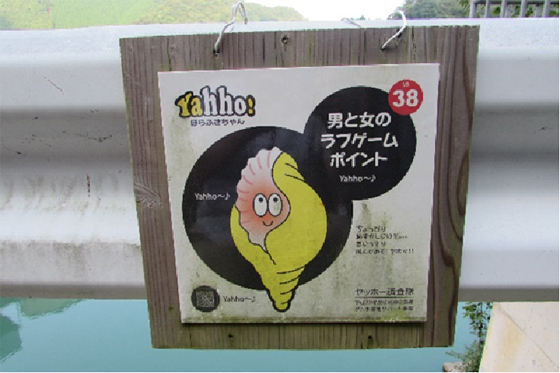
A sign for the Boy and Girl Love Game Point, one of more than 80 yoo-hoo spots.
Bringing Happiness to Everyone via Nature
Finally, I asked Mr. Takeichi about his future plans.
“In today’s Japan,” he said, “for a variety of reasons, the number of men and women who don’t know how to associate with the opposite sex is increasing, so even minor incidents escalate into problems like sexual harassment. I think the lack of communication between the sexes in people’s younger days is playing a part here. In the past there was folk dancing at junior high school sports days, and boys and girls used to take part together. But these days there is almost no folk dancing. It’s a great pity.”
“In an age like this, our yoo-hoo and conch shell experiences are being used in school trips and company training. In the program we try to encourage people to come together. For example, boys and girls pair off and make heart marks. Before they start, they think it’s rather stupid. But when they finish, they often tell us that the participants themselves, be they students or colleagues, have drawn closer together. It seems to have an effect in improving human relations.”
“I would like to turn Kamikatsu-cho as a whole into a natural theme park, a happy world, so that local people and visitors to our town can all enjoy themselves and be happy.”
The beaming face of Mr. Takeichi, who is in his mid-fifties and became a grandfather this year, is full of love for humankind and love for Kamikatsu-cho.
Cooperation
Irodori Co., Ltd.
http://www.irodori.co.jp/ (Japanese site only)
Kamikatsu Yoo-Hoo Research Team
http://ameblo.jp/kmktyahhoo/ (Japanese site only)
